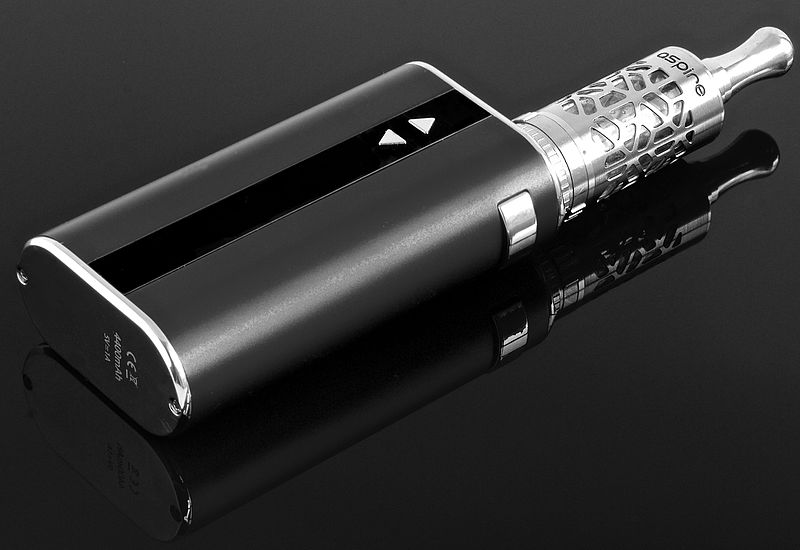A young man stands hidden in his yard with his back turned to a large brick house. White smoke billows from his mouth in a cloud. The smoke appears to be from a cigarette or cigar, but it smells fruity. As he turns around, a slender, glowing metal device is visible in his hand. He, like many others, appears to have joined the rising trend of people who use vaporizers.
The vaporizer that the young man uses has become a popular product in recent years due to its price, “coolness factor” and apparent fewer health risks. Signs in front of stores and restaurants have even begun to add “no vaping” because of the increase of its use.
Teens seem to be particularly intrigued by the idea, but adults often worry about what vaporizers could be doing to their kids and the environment.
Vaporizers are devices that hold a liquid that can be burned and smoked. The juices put into the vaporizers can contain different amounts of nicotine. Originally, the idea behind vaporizers was that the people could slowly wean off of their nicotine addiction by buying less nicotine in their juices each time; however, people now use them simply as an alternative to cigarettes. Teens, in particular, tend to do this. The catch is that teens shouldn’t even be using them. They are not legal to anyone under 18; yet, according to livescience.com, 27.9 percent of teens have tried a vape. Bobby (who did not wish to give his last name), from SS Vape said that the only reason teens can’t use vaporizers is the nicotine they have in them.
“There isn’t really anything dangerous in the juice. Most of them only have propylene glycol, vegetable glycol, nicotine and natural flavoring,” said an employee from AVAIL Vapor, who prefers to remain anonymous.This is an example of the problems some people have with the juices.
“Okay, so most juices only have those four things in them, but not all,” said Sophy Blumberg, a sophomore at Middletown High School. “Is the ingredient ‘natural flavors’ not particularly clear to anyone else?” There is no evidence that that truly is all that’s in the juices. The FDA has yet to approve them, which means customers may not even know what they’re buying.
“Vapes just haven’t been around long enough for the FDA to approve them,” said the employee from AVAIL Vapor. She may be right that consumers haven’t known about them for long, but the fact is that Herbert A. Gilbert created the first known vaporizer in 1963.
“The FDA is just looking for a reason to regulate it for taxes,” said Bobby from SS Vape.
Many other people, including teachers and students, tried to explain why the FDA has yet to approve vaporizers; however, quite a few people simply admitted that they don’t know the reason. The main reason is really just that the FDA is still exploring the device. The risks, amount of nicotine and other chemicals and possible benefits are all still being investigated.
Research shows that due to the variations of vaporizes, it’s very hard to answer those questions expeditiously. The worry is the health problems that could accompany the use of vaporizers, which is already being seen. The FDA has seen many adverse events occur from using vapes, including pneumonia, congestive heart failure, seizures and hypotension.
“I’ve seen a guy with mold or something in his lungs from the water vapor because he used his so much,” said Declan Sullivan, MHS junior. He explained how his friend was having trouble breathing then had to go to the hospital because of it.
“I still don’t really know what it did to him, though.”
The “water vapor” is a controversial topic; some say it’s not water so it can’t be called that. The unclear ingredients are the biggest obstacle to an otherwise booming business.
“Nicotine is the most dangerous part of the juice and there’s an option for no nicotine,” said Alex Leaman, MHS junior.
Propylene glycol, said to be the main ingredient in the juices, has been studied for many years and isn’t all bad. It is used in inhalers, so there’s hope yet to those who want vapes to be approved.
“A lot of teens are honestly starting to use them because they’re peer pressured into doing it to be ‘cool,’” said an MHS student who would prefer to remain anonymous. “I’ve done that before and it was an extremely ignorant decision on my part.”
Until given more information on vaporizers, people are left to make their own judgments on the risks involved in using them.
Timothy Leber, MHS health teacher, said, “I don’t know a lot about them, but I don’t think they’re worth risking your life for. As for teenagers, do what’s right. Smoking is something you just know isn’t right. In my opinion, I wouldn’t go up to a car and breathe in the exhaust fumes, so why smoke anything else?”












